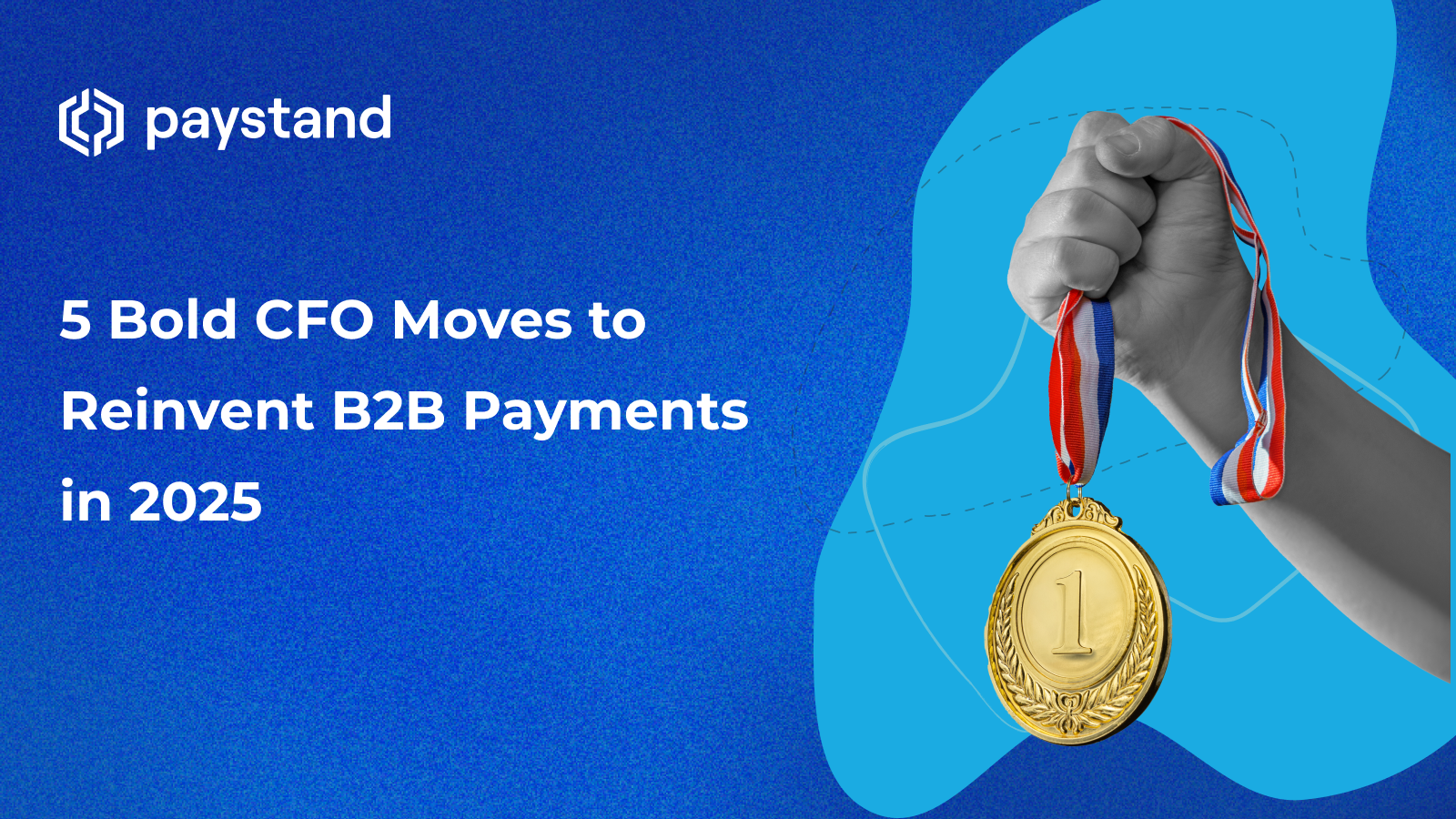5 Bold CFO Moves to Reinvent B2B Payments in 2025

Table of contents:
- Embrace the Digital Transformation of B2B Payments
- Leverage Automation and Artificial Intelligence
- Tap Into Blockchain for Transparent and Secure Transactions
- Prioritize Cash Flow Management
- Foster Financial Agility
Key Takeaways
- Embrace digital and cloud payment solutions to streamline B2B transactions and improve operational efficiency.
- Leverage AI and automation for smarter, faster workflows that enhance cash flow visibility and decision-making.
- Utilize Blockchain for secure, transparent payments, which is especially useful in cross-border scenarios.
- Incentivize cost-effective payment options to accelerate cash inflows and reduce transaction expenses.
- Prioritize financial agility by adopting flexible tools and real-time data to adapt quickly to market changes.
2024 was marked by efficiency—focusing on incremental improvements, cost reduction, and streamlined processes in response to economic pressures. While these measures provided stability, true transformation demands a bolder approach. In 2025, the CFOs who will define the future of finance aren’t just refining existing strategies; they’re embracing emerging technologies like AI, blockchain, and advanced analytics to unlock unprecedented value.
Marginal gains may sustain the status quo, but real value creation comes from daring to innovate. Here are five bold moves CFOs can make to reinvent B2B payments, drive financial agility, and position their organizations for long-term success.
1. Embrace the Digital Transformation of B2B Payments
The digital shift in B2B payments has gone beyond mere online transactions. It now involves key technologies like payment gateways, embedded payment solutions, and cloud-based systems that simplify financial operations.
For CFOs, this digital foundation is essential for creating a payment infrastructure that can respond to changing market conditions while enabling more accessible and efficient transactions.
Embedded B2B payments
These systems allow businesses to accept and process transactions within the ecosystems they already use, eliminating friction in the payment process and, ultimately, enhancing the customer experience.
Payment gateways
Most of the times in hand with embedded payments, a payment gateway further enhance transaction speed and reliability, creating a seamless flow that minimizes payment delays.
Cloud-based solutions
Although legacy systems remain the standard across businesses, new cloud-based solutions are becoming default options in B2B payments. They offer scalability and flexibility, helping businesses adapt quickly to market demands and maintain continuity.
2. Leverage Automation and Artificial Intelligence
Automation and Artificial intelligence (AI) have transformed the accounts payable and receivable processes, offering powerful tools for CFOs to optimize workflows and reduce manual tasks.
In 2025, these technologies will become even more sophisticated, with AI-driven insights helping finance leaders make more informed decisions. Automation frees up the finance team’s time, accelerates routine tasks, and reduces errors, ultimately improving efficiency. In the accounts receivable (A/R) space, automation can streamline invoicing, payment reminders, and collections, reducing the time and resources required to manage these processes.
Together, automation and AR improve financial reporting accuracy, freeing the finance team’s time to analyze, anticipate, and create action plans for potential cash flow issues. By investing in AI and automation, CFOs can focus on strategic decision-making.
3. Tap Into Blockchain for Transparent and Secure Transactions
Blockchain technology reshapes payment transparency and security. Blockchain provides an immutable record of transactions, helping CFOs address some of the most pressing concerns in B2B payments: security, traceability, and fraud prevention. It also enhaces trust between businesses and reducing the risks associated with traditional payment methods.
For CFOs focused on both security and efficiency, blockchain can serve as a valuable tool in creating a future-proof B2B payment strategy.
Blockchain for cross-border payments
Blockchain offers a significant opportunity for streamlining cross-border payments, a critical area for businesses operating on a global scale. With blockchain-enabled transactions, businesses can reduce intermediaries, lower transaction fees, and accelerate payment times.
4. Prioritize Cash Flow Management
A robust cash flow strategy allows companies to maintain liquidity, meet operational needs, and respond to market opportunities without relying on costly financing options. Digital payments and automation can play a pivotal role here by accelerating receivables and improving the predictability of incoming cash.
By encouraging timely payments and improving visibility into receivables, CFOs can minimize the impact of late payments and optimize their cash reserves.
A Healthier A/R
A critical tactic in cash flow management is to incentivize profitable payer behavior. By encouraging customers to use low-cost or fee-free payment options, CFOs can accelerate cash inflows and reduce transaction expenses. Moving away from traditional payment methods that incur high fees not only boosts the bottom line but also shortens the time to receive cash.
Effective cash flow management requires the right tools, but also strategic choices about how payments are structured and incentivized, which collectively support long-term financial resilience.
5. Foster Financial Agility
Financial agility means responding quickly to market changes and new opportunities. In 2024, finance teams focused heavily on building efficiency, reducing costs, and optimizing resource allocation. As we move into 2025, CFOs will need to refine this approach further by creating an agile financial infrastructure that can pivot when needed. This involves adopting flexible financial tools, using real-time data for decision-making, and ensuring the finance team can adapt to evolving priorities.
Agility is about adaptability. CFOs with agile finance operations can respond faster to economic or industry shifts, repositioning their organizations as challenges or opportunities arise.
The Path Forward
As we head into 2025, CFOs stand at the forefront of a transformed financial landscape. By investing in digital payment solutions, harnessing AI and automation, exploring blockchain, prioritizing cash flow, building financial agility, and enhancing the customer experience, finance leaders can navigate challenges with confidence. These 5 strategies position businesses for sustainable growth, ensuring they remain competitive in the evolving B2B payments ecosystem.
Looking to deepen your strategy for 2025? Download the eBook, Future of Finance 2025, and gain insights to drive digital transformation, leverage AI, enhance financial agility, and set the foundation for a resilient and future-ready finance team.






